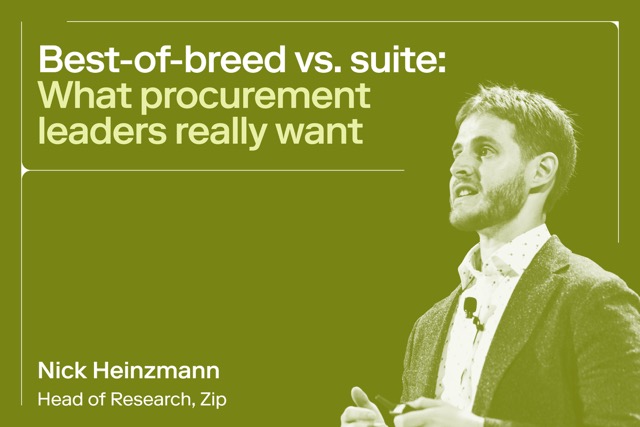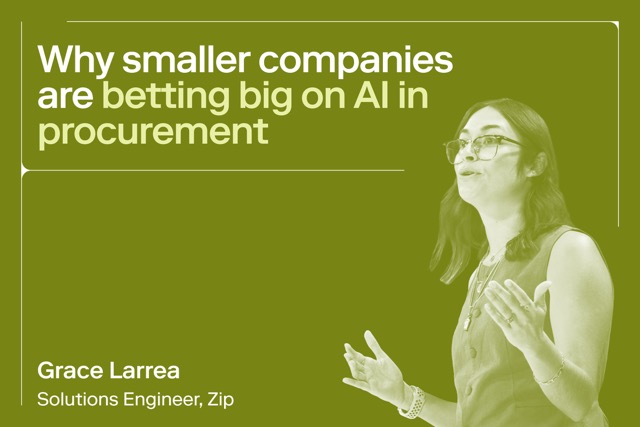
Guide to integrating ERP with P2P
Find out the benefits of ERP-P2P integration and how to execute it effectively.

Integrating Enterprise Resource Planning (ERP) and Procure-to-Pay (P2P) solutions means creating a seamless flow between the financial and procurement systems finance teams use every day.
A tight integration of these systems can help with reducing maverick spend, enhancing spend visibility across organizations, and controlling costs more effectively. But even trends are dictating an even broader integration of these processes and systems.
As Nick Heinzmann notes in his recent newsletter, Intake-to-Pay is ‘eating’ Procure-to-Pay “by solving first for adoption by end stakeholders, so it can drive greater visibility of spend, proactive influence on stakeholder demand, and continuous optimization of the end-to-end procurement process via a broader procurement orchestration layer.”
In this guide, we’ll take a look at why this integration is so important, and how businesses can evaluate P2P/ERP integrations to enhance the procurement lifecycle.
We’ll also take a look at how Zip’s procurement orchestration platform, which starts off the entire process with intake, is pioneering the way companies are reimagining the entire procurement experience from Intake-to-Pay.
What is ERP integration with P2P?
ERP integration with P2P signifies a cohesive system where procurement processes, from the initial request to payment, are streamlined and visible within the ERP system.
This integration is gaining traction due to the need for better vendor management, the shift towards digital invoicing and payments for fraud reduction and enhanced visibility, and the demand for improved user experiences given the often poor intake processes of ERP systems versus dedicated procurement orchestration platforms.
Several market trends and operational challenges have spurred businesses to consider integrating their ERP and P2P systems now more than ever:
Improving Supplier Relationships
Supplier relationships can be a make or break function of a healthy business. Integrating ERP with P2P systems allows businesses to manage their supplier information more effectively, streamline the procurement process, and ensure timely payments. Doing so can increase supplier satisfaction, which can pay long-term dividends in healthy partnerships.
Moving to Digital Invoicing and Payments
The shift towards digital invoicing and payments is another significant trend driving ERP and P2P integration. By adopting digital processes, companies can reduce the risk of fraud, minimize errors, and improve the efficiency of their payment processes. Digital invoicing also provides greater visibility into spending, helping businesses better manage their cash flow and financial planning.
Enhancing User Experience
One of the shortcomings of many ERP systems is their poor intake processes, which can hinder user adoption and operational efficiency. On the other hand, P2P solutions are designed with user experience (UX) in mind, offering intuitive interfaces and streamlined workflows. Integrating these systems allows companies to leverage the strengths of both, creating a more user-friendly environment that encourages adoption and maximizes the value of their investment in technology.
Benefits of integrating ERP and P2P
As organizations strive to optimize their procurement process and enhance their supply chain management, a tight integration between ERP and P2P systems offers several benefits that can be felt across the entire organization.
Streamlined purchase processes and procurement cycles
The integration of ERP and P2P systems dramatically streamlines the purchasing process. By automating the procurement workflow, businesses can significantly reduce the time from purchase requisition to order fulfillment. This acceleration not only boosts efficiency but also enhances the agility of the procurement process, enabling organizations to respond swiftly to market changes and business needs.
Enhanced data accuracy across payment and ERP systems’
One of the primary challenges businesses face is maintaining data accuracy across disparate systems. Integrating ERP and P2P solutions ensures that data related to purchase orders, invoices, pricing and payments are consistent and accurate in real-time. This synchronization eliminates manual data entry errors, enhances decision-making, and supports robust forecasting and financial planning.
Increased spend visibility across the organization
Gaining comprehensive visibility into organizational spend is a game-changer. ERP and P2P integration offers unparalleled insight into procurement activities, enabling stakeholders to track and manage spend effectively. This heightened visibility helps identify cost-saving opportunities, minimize shadow spend, and optimize supplier management, contributing to substantial cost savings and improved supplier relationships.
Cost savings through automation and orchestration
The automation of procurement and accounts payable processes significantly reduces manual labor, cutting down on inefficiencies and associated costs. Reducing manual processes, combined with the elimination of redundant purchases and shadow spend, directly translates into cost savings. Moreover, automation powered by machine learning and AI technologies further refines procurement operations, making them more efficient and scalable.
Improved compliance with regulations
Integrating ERP and P2P systems strengthens compliance with regulatory requirements such as the Sarbanes-Oxley Act (SOX). By providing detailed audit trails and enforcing approval hierarchies, organizations can ensure adherence to compliance standards, minimize risk, and uphold corporate governance.
As organizations continue to navigate the complexities of digital transformation, leveraging the power of ERP and P2P integration becomes essential. By adopting integrated ERP and P2P solutions, businesses can not only optimize their business processes but also position themselves for sustainable growth and competitive advantage in the global marketplace.
Potential risk of integrating ERP and P2P systems
Like any significant technological transformation, this integration comes with its set of potential risks. Be sure to consider these potential problem areas as you plan out your integration strategies.
Retraining the entire organization on new workflows
The implementation of integrated ERP and P2P solutions often necessitates a shift in existing workflows, which can be a significant change for an organization. The requirement to retrain employees on these new processes underscores the importance of selecting an intuitive solution that minimizes the learning curve and maximizes user adoption. An unintuitive system can lead to inefficiencies and reduced productivity, highlighting why user experience (UX) should be a priority in the selection process.
Time-consuming and complex integration
The path to achieving a seamless integration between ERP and P2P systems can be fraught with complexities, often requiring significant time investment. While these challenges are inherent to integrating sophisticated systems, solutions like Zip offer streamlined processes designed to simplify and accelerate integration. Opting for a solution that emphasizes ease of integration can help avoid prolonged disruptions to business operations.
Compatibility issues due to different data formats
ERP and P2P systems often utilize different data formats, leading to compatibility issues that can hamper the integration process. Ensuring seamless data flow between systems necessitates robust API (Application Programming Interface) management and possibly custom integration efforts. Overcoming these compatibility issues is crucial for the real-time synchronization of purchase orders, e-invoicing, and payments, ensuring the accuracy and reliability of financial data.
Security risks as data flows through multiple platforms
Integrating ERP and P2P systems involves the transfer of sensitive data across platforms, potentially exposing the organization to security risks. Ensuring the security of data as it moves between systems requires a comprehensive approach to cybersecurity, including the implementation of encryption, secure data transfer protocols, and regular security audits. Selecting solutions that prioritize data security and are compliant with industry standards can mitigate these risks.
By prioritizing intuitive user interfaces, opting for solutions designed to simplify integration, ensuring compatibility through effective API management, and emphasizing robust security measures, organizations can navigate these risks and fully realize the benefits of ERP and P2P integration.
How to plan an integration of ERP and P2P solutions
Integrating P2P and ERP solutions is a strategic move that promises to streamline eprocurement processes and enhance financial operations. However, the success of this integration hinges on meticulous planning and execution. Here’s a step-by-step guide to effectively prepare and plan for an ERP and P2P integration.
- Define your business requirements
Before even beginning the process, it’s important to have a clear understanding of your organization’s specific needs. Identify the pain points in your current procurement and financial processes and determine how an integrated ERP and P2P system can address these issues. Consider factors like scalability, data accuracy, spend visibility, and compliance requirements.
- Vet and select a suitable P2P solution
With your requirements in hand, begin the vetting process for P2P solutions that complement your ERP system. Look for solutions that offer seamless integration capabilities, intuitive user experiences, and robust security features.
Zip is an option that adds an Intake-to-Pay layer on top of legacy ERP systems, offering employees a ‘single front door’ for purchase requests that teams actually love to use.
- Conduct a gap analysis
Perform a gap analysis to identify discrepancies between your current processes and the capabilities of the integrated system. This involves mapping out existing workflows and comparing them with the new processes that will be enabled by the ERP and P2P integration. Understanding these gaps will help in developing a detailed plan to address them, ensuring a smoother transition.
- Develop an integration plan
With a chosen P2P solution and a clear understanding of the gaps, it’s time to develop a comprehensive integration plan. This plan should outline the technical steps required for integration, including data migration, system configuration, and customization.
- Implement internal change management
Change management is critical to the success of any integration project. Prepare your organization for the upcoming changes by communicating the benefits of the integrated ERP and P2P systems. Organize training sessions to familiarize employees with the new processes and interfaces.
- Test and go live
Before fully deploying the integrated system, conduct thorough testing to ensure that all components work as intended. This should include testing data flows between the ERP and P2P systems, as well as user acceptance testing to confirm that the system meets your business requirements. After successful testing, proceed with the go-live phase, closely monitoring the system for any issues that need immediate resolution.
How Zip enables an integration of P2P capabilities with ERP systems
Zip is pioneering new ways businesses integrate Procure-to-Pay (P2P) capabilities with Enterprise Resource Planning (ERP) systems. By introducing an innovative procurement orchestration layer that starts with Intake, Zip is transforming legacy ERP systems into agile, efficient, and comprehensive procurement operation platforms.
Zip’s global payments capabilities sync with ERPs to post all relevant funding and transaction records in real-time to a company’s ERP.
- Zip also grants requesters visibility into the open POs, invoices, and payments, without requiring them to have licenses to those other systems, reducing troubleshooting and access management issues.
- Zip’s spend analytics gives you a full view of the spend lifecycle that legacy ERP systems miss. You can see exactly what’s been purchased and where payments are going.
- Zip enables AP automation and stronger PO management. It ends manual processing of invoices by addressing issues at the root—the intake process. By standardizing and speeding up PO and approval process workflows and solving common issues with invoice processing, Zip offers solutions across the entire P2P process.
Interested in seeing how Zip can transform your business's procurement operations? Book a demo today and explore the full potential of integrating P2P capabilities with your ERP system.
Discover a smarter, more efficient way to manage procurement and payments with Zip.

Maximize the ROI of your business spend

Enter your business email to keep reading



























.webp)




















.avif)













.avif)










.webp)




.avif)












.avif)
